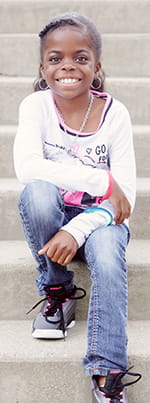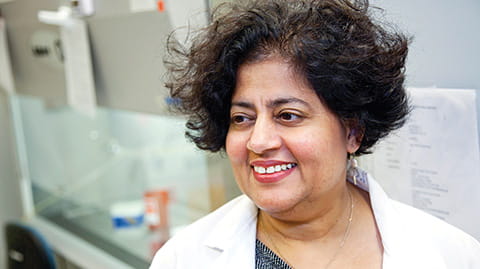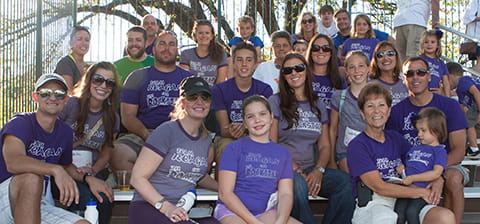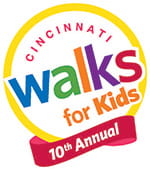Innovative Treatments Provide New Hope
For more than 130 years, Cincinnati Children’s has been on the cutting edge of advancing discovery to help kids in our community – and all over the world – get and stay as healthy as they can be.
Our world-class teams have pioneered many major medical breakthroughs over the years. Innovative technologies like the first practical heart-lung machine, pioneering surgical procedures for tracheal reconstruction and game-changing vaccines for life-threatening diseases like rotavirus and polio.
Together, these discoveries have saved or improved the lives of millions of children.
Yet, we believe our greatest innovations are still to come.
As we celebrate the 55th anniversary of Sabin Sunday, a day in April 1960 when thousands of families from across the country lined up at Cincinnati Children’s to receive free doses of Dr. Albert Sabin’s life-saving oral polio vaccine, we recommit ourselves to this work.
But we can’t do it alone. With your partnership, we will never stop moving forward to make a difference for children. Together, we are uncovering new treatments, fighting for cures and preventing suffering.
 Pioneering Innovative Treatments
Pioneering Innovative Treatments
Despite living with sickle cell disease, Shanoah is able to enjoy an active lifestyle thanks to an innovative treatment pioneered at Cincinnati Children's.
Shanoah is a dynamic 12-year-old who loves gymnastics, cheerleading and spending time with her parents and big brother.
But frequent bouts of intense pain can keep Shanoah from the active lifestyle she loves. Shanoah has sickle cell disease (SCD) – a genetic blood disorder that causes red blood cells – normally round – to become sickle-shaped. These crescent-shaped cells have difficulty passing through small blood vessels, which means they cannot deliver oxygen efficiently throughout the body. This causes excruciating pain.
Children with SCD are frequently hospitalized and given blood transfusions to alleviate their pain episodes. Long term, the disease can lead to severe health complications, like organ damage and even stroke.
“When I have a pain crisis, I feel sharp pains and pressure – it feels like someone is squeezing,” says Shanoah. “When this happens, I take my medicine and cuddle with my dog, Infinity, because it makes me feel better.”
Russell Ware, MD, PhD, director of Hematology at Cincinnati Children’s, is working to help kids like Shanoah. His team led a study that tested the effectiveness of a drug, originally developed as a cancer treatment, on patients with SCD – hydroxyurea. The drug prevents red blood cells from forming into the sickle shape that causes the pain and organ damage that people with SCD endure.
“I remember thinking, ‘If this drug helps our daughter manage the intense pain, we should look into it further’,” says Sonya, Shanoah’s mom. They decided to introduce hydroxyurea into Shanoah’s daily care management routine. And it’s changed her life.
“Since I’ve been on this medicine, I feel so much better and can do everything just like a regular kid can,” says Shanoah.
Thanks to the medication, Shanoah now averages about one admission to the medical center per year – before, she was being admitted to the hospital once every two or three months. She has also been able to cut back on antibiotics and pain medications she used to take around the clock for days at a time.
“This medication has changed the game for Shanoah and other kids with this disease,” Sonya adds. “We’re so thankful for the research at Cincinnati Children’s that helped this drug become a reality for my daughter.”
Already at the forefront of many rare and complex diseases, researchers like Punam Malik, MD, are positioning Cincinnati Children's as a leader in gene therapies that have the potential to cure more children.
Gene Therapies Provide New Hope
Treatment with hydroxyurea is now offering symptom relief to many who suffer with SCD. But until there is a cure for the disease, there is more work to be done. That’s why researchers at Cincinnati Children’s continue to pursue gene therapies to eradicate the disease entirely.
Punam Malik, MD, program leader for the Hematology and Gene Therapy Program and director of the Comprehensive Sickle Cell Center and the Translational Laboratory at Cincinnati Children’s, is recognized internationally for her work to end the suffering for children with sickle cell disease.
Dr. Malik’s research has the potential to create a one-time gene therapy for those with SCD. The therapy uses stem cells that are taken from the person’s own bone marrow. The cells are then manipulated so they produce red blood cells that can’t sickle. The “new” cells are then be reintroduced into the patient’s body to make sickling-resistant red blood cells for the rest of the individual's life, providing a one-time treatment for the disease.
“Currently, patients with sickle cell disease must utilize hydroxyurea as a daily medication or get regular blood transfusions to manage their disease,” says Dr. Malik. “By developing a gene transfer therapy, we can essentially end sickle cell-related symptoms for those with the disease, which will allow them to live a happy and pain-free life. This therapy will work just like hydroxyurea does, but will be a one-time, permanent treatment.”
Advancing Discovery – Changing Lives
Our commitment to improving the care – and lives – of children through the application of research discovery is the backbone of Cincinnati Children’s.
Today, across more than 50 research divisions, our teams continue to work together to generate new discoveries. Working together, we are teasing out the secrets of human development and disease. We are developing new technologies to detect the precise levels of medication coursing through a child with cancer. We are making new advances with child-sized artificial hearts and tiny devices that can change how bones grow.
With donor support, many more amazing discoveries will emerge in the years to come – all to improve the health of children in Cincinnati and around the world.
To learn more or support our research efforts, contact Beth Sims at 513-636-5285 or beth.sims@cchmc.org.








